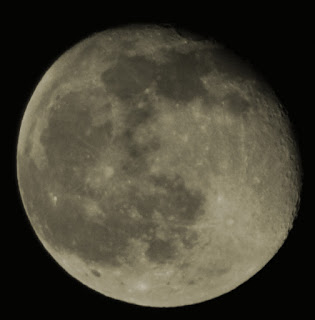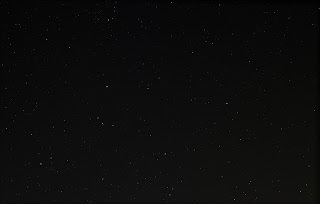February 27th 2115 GMT Deep
Sky
With observations of Venus and the Sun
and a clear sky in the afternoon, I eagerly anticipated nightfall. My hopes
were dashed at 1930 GMT when I could not see a single star.
Fortunately, it cleared later, only for
me to mis-snap the Pleaides (M45), as my zoom lens was set on macro. I reset my
camera but cloud had moved in and it was a case of moving from object to object
until it got too cloudy and cold to continue.
I set my camera at 70mm focal length, ISO
6400 and 8 seconds exposure. I originally intended to take several shots of a
few objects at different focal lengths but went for quantity instead, aiming at
the Hyades, Orion Great Nebula (M42), Beehive (M44), M41 and Melotte 111 on a single setting. At the end of the shoot, I shot 15 dark frames.
I stacked 7 frames of the Hyades and used the master dark frame.
I only had 3 useable frames of the Orion Great Nebula (M42) and cropped a lot of cloud from the fional image.
M41was low in the murk with lots of cloud. I cropped out everything except the cluster and got a result of sorts.
February 27th 1200 GMT Sunspot
It was nice to get some continuous solar
action at the end of the month, although the weather forecast for the next few
days (at the time of writing) meant that I expected to be processing and
blogging for most of the next week.
February 27th 0555 GMT Venus
I snapped Venus, which appeared to be
brightening in the dawn sky at 300mm focal length, ISO 100 and 1/400 second
exposure.
February 26th 0940 GMT Sun
The sunspots had rotated on the solar disc but their orientation was due to me observing earlier in the day than the evening before.
February 27th 2115 GMT Deep
Sky
With observations of Venus and the Sun
and a clear sky in the afternoon, I eagerly anticipated nightfall. My hopes
were dashed at 1930 GMT when I could not see a single star.
Fortunately, it cleared later, only for
me to mis-snap the Pleaides (M45), as my zoom lens was set on macro. I reset my
camera but cloud had moved in and it was a case of moving from object to object
until it got too cloudy and cold to continue.
I set my camera at 70mm focal length, ISO
6400 and 8 seconds exposure. I originally intended to take several shots of a
few objects at different focal lengths but went for quantity instead, aiming at
the Hyades, Orion Great Nebula (M42), Beehive (M44), M41 and Melotte 111 on a single setting. At the end of the shoot, I shot 15 dark frames.
I only had 3 useable frames of the Orion Great Nebula (M42) and cropped a lot of cloud from the fional image.
M41was low in the murk with lots of cloud. I cropped out everything except the cluster and got a result of sorts.
February 27th 1200 GMT Sunspot
February 27th 0555 GMT Venus
February 25th 2110 GMT Meteor Hunt and Constellations
I processed the fourth set differently. Although there is more skyglow, the Beehive Cluster (M44) at the top right (north west) of the photograph shows very well.
By the time I got to the fifth set of frames, dew was starting to become a problem and it was the last useful set of shots.
February 25th 1140 GMT Sun
The sunspots I had seen the day before
had changed and had become equal in size and intensity. A binocular scan had
shown them.
February 24th 2115 GMT Meteor Search
February 24th Lunar Reprocess
February 24th 1900 GMT Betelguese
February 24th 1220 GMT Sun
February 23rd Lunar Reprocess
February 23rd 1340 GMT Sun
February 23rd 0620 GMT Venus
February 23rd 0520 GMT Moon
February 22nd 1340 GMT Sun
February 22nd Constellation and Meteor Shoot Reprocess
February 21st 1915 GMT Betelguese
February 21st Constellation and Meteor Shoot Reprocess
February 20th Constellation and Meteor Shoot Reprocess
February 20th Jupiter and Saturn Reprocess
February 18th 2210 GMT Moon
February 17th Reprocess
February 16th 2215 GMT Moon
February 16th Constellation Reprocess
February 15th Constellation Reprocess
February 14th Moon and Betelguese
February 14th Constellation Reprocess
February 13th Constellation Reprocess
February 13th Jupiter with Saturn Reprocess
February 12th Jupiter with Moons Reprocess
February 12th 0025 GMT Moon
February 11th Solar Reprocess
February 11th 1220 GMT Sun
February 10th 1930 GMT Betelguese
The Moon was too bright for
constellation, meteor or deep sky photography. I checked the brightness of
Betelguese and estimated it at 0.5.
February 10th 1745 GMT Moon
I snapped the Moon at 300mm focal length,
ISO 100 and 1500 second exposure.
February 9th 1000 GMT Sun
February 8th Meteor Reprocess
February 8th Widefield Reprocess
February 7th Deep Sky Reprocess
February 6th 2040 GMT Betelguese and Moon
Although the sky was clear, the wind was
still very strong. This would have made photography very difficult and also
there was a risk of the camera blowing over on its tripod.
I checked the magnitude of Betelguese at
about 0.45 and snapped the low crescent moon with my DSLR at 300mm focal
length, ISO 100 and 1/400 second exposure.
I had underexposed the image, possibly a misjudgement of the extinction due to the low elevation. Perhaps 1/200 or even 1/160 second would have been better. After the success of February 4th, this was a disappointment and I felt I had missed an opportunity.
February 5th 1135 GMT Sun
The Sun was in a bank of thin cloud, so I
checked it with my binoculars and filter. I did not see any of the small
sunspots on the Learmonth images but saw the single, large sunspot and made a
drawing.
February 5th 0750 GMT Venus
Venus was low in the east around sunrise,
appearing as a “morning star”. I scanned it with my binoculars to reveal a thin
crescent.
February 4th 2145 GMT Betelguese
It was too cold and windy to go out and I
had visions of my DSLR shattered on the ground. I had to let our dogs out and
I’m sure that they notice Sirius (the Dog Star!).
February 4th 1740 GMT Moon
February 4th 1045 GMT
I bin scanned the Sun. The sunspots I had seen two days earlier were no longer visible in my binoculars but another one came into view near the centre of the solar disc.
February 2nd 1050 GMT Sun
The Sun was bright but behind a bank of thin cloud. I bin scanned it with my binoculars and filter and caould see two large sunspots.































































